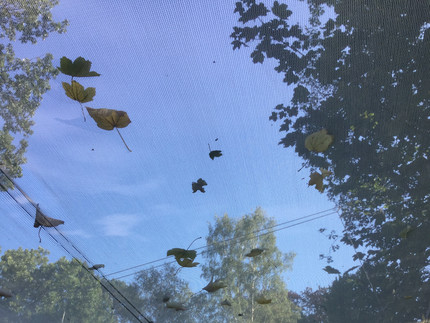Vartika Maurya: Ecopolis Berlin? Nature in the City
There is no Berlin novel written on the subject of man and environment, therefore I made some of the city's green and eco-friendly sites my areas of research.
Prinzessingarten: The Prinzessingarten is located in Kreuzberg 36 . Here plants and crops are cultivated, locally and ecologically. The garden as a whole is mobile. Bar, kitchen, workshop and storage rooms are located in disused and converted overseas containers, planted in raised piles of stack containers and in rice sacks. Independent of the ground soil, this method of cultivation and the use of food-safe materials allow for an ecological cultivation in the city, where most of the available land is either sealed or contaminated. In addition to that , a mobile garden opens the possibility for a temporary use.
The area at Moritzplatz rents the Prinzessinnengarten from the city administration. The rent and all other costs are borne by the garden itself. Revenues are generated by garden catering and the sale of vegetables, from funds that the garden acquires for the realization of various educational projects, from the construction of other gardens, consulting services, fees for pictures, lectures and guided tours and donations in the form of gardenbed sponsorships. Many people volunteer here to make such a place possible. As a framework for the various social, educational and economic activities, the founders of the garden have established a non-profit company called Nomadisch Grün, whose main concern is to make the garden a place of learning. It's all about forms of informal learning. Knowledge is acquired through practical experience and the exchange of knowledge .
During my stay in Berlin I ended up visiting Kreuzberg on different occasions and it always came across as a multicultural space : a place where people from different ethnicities co-exist . Also for me personally the Prinzessingarten was a place which was very organic in its approach. One could sit there for hours . I saw people coming there and devoting time to their art , writing a journal, and creating music sitting under a tree . It is also a place for alternative learning , where an exchange of oral and practical knowledge takes place. It is also a perfect example of harmony between humans and nature in an urban space . Berliners come there and grow their plants and take care of the plants , they have a connection with they are doing. It is a successful attempt to bring nature back to the city.
Urban Beekeeping: Apart from urban gardening , urban beekeeping is another initiative adopted by the city dwellers in Berlin. Urban beekeeping has been practiced in metropolitan cities like New York and Paris, too. Berlin has been a thriving landscape for bees. There are about 4 lakh tress in Berlin , which makes 1\5 of the city area covered with forest. Since a few years Berliners have been working towards increasing the number of bee colonies and towards increasing the percentage of native honey produced through urban bee keeping . Bees are the third most important live stock after cattle and pork. In the past decade 30 % of the German bee population has disappeared, the causes being pollution by pesticides, diseases in the bee population and the aging of the beekeeper. The 3000 Berliners who have been practicing bee keeping as a hobby are guided by 500 professional beekeepers .
The founder of the berlin beekeeping community “Berliner Honig “ Annette Mueller has her shop in Berlin, where pallets full of glasses on which not only the name of the flower, but above all the name of the beekeeper is noted . This also creates a connection with what one produces. The honey from urban beekeeping is not organic honey with a certificate, but its natural, comes from fair trade and its greatest advantage is its regionality. Berliners have bee hives set up in their balconies and their terraces. Many students in the Freie University Berlin have become amateur urban beekeepers and enjoy this as a hobby and like contributing towards producing berlin honey .
Tempelhofer Feld : Berlins Tempelhofer Feld was one of the first airports in Berlin . Originally the Tempelhofer Feld was a parade ground for military drills and on holidays Berliner would visit the site for recreation and leisure. In 1920 an airport was built on the site . Later in the year 2008 a referendum was conducted , where the Berliners decided in favour of the closing down of the airport . The park which we now see was made accessible for public use in the year 2010. The city dwellers of Berlin reclaimed the 386 hectares of open space and one of the world’s largest buildings, which is about 1.2 km wide, for public use. Today the decommissioned airport has been converted into a park and has a 6 kilometers cycling area .
Another unique aspect of the park is , that it has become a habitat for open country birds, considering that it is huge, flat and gradually returning to nature. The old runways and service roads are still there but the areas between them are not mowed very often . Some of the areas have been allowed to go completely wild and nature finds its way back, whenever human turns his back. Now the Tempelhofer Feld has become the largest public park in Berlin and a birdwatcher’s paradise . The Tempelhofer Feld can be perceived as a coming together of wild nature and something man made. The transformation of a decommissioned airport into a habitat and the man and natur harmony is a unique aspect of the sight.

